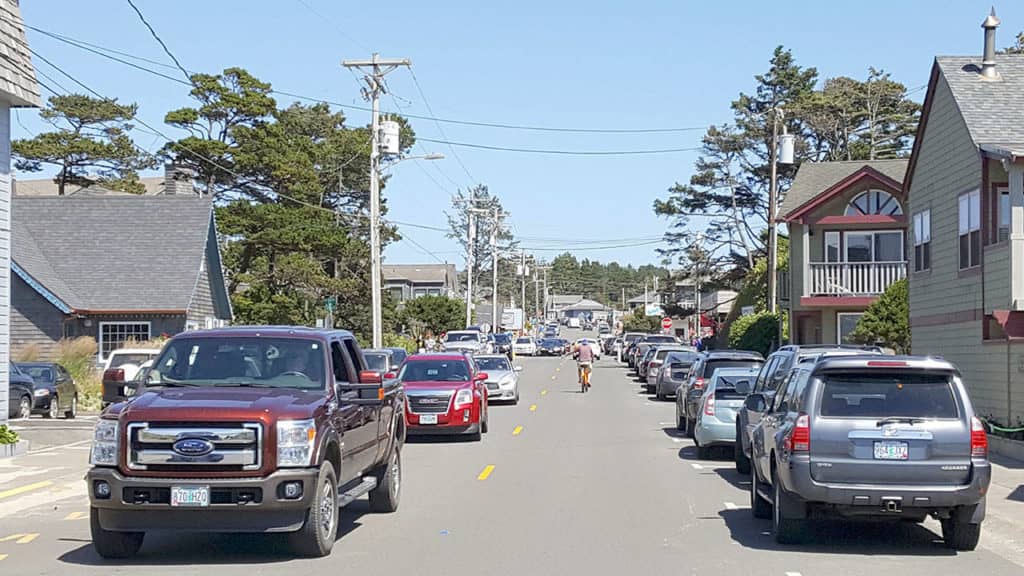By Kim Rosenberg
I understand why people are upset about the proposed Steeplejack Brewpub/arcade/”hotel” (in Manzanita). Even folks who welcome a new place to eat burgers and drink fancy beer or want a place to take kids while eating burgers and drinking fancy beer wonder about parking and street congestion and where the 25 employees will come from when our existing businesses struggle to stay fully staffed and operational, as it is.
Some people wish for an entirely different type of business but that’s not we get to decide.
Kind of like a board game, our Zoning and Ordinances are the rules for the Development and Building game in town; they’re meant to make manifest the town that our Comprehensive Plan describes–a residential village with natural amenities. Zoning maps show what type of development goes where–houses in the residential zones, businesses in the commercial zone. Ordinances are the rules that give the how-to nuts and bolts–the sizes of buildings, the set backs, and the parking requirements, for example. Decisions are made by the Planning Commission, and the Council based on the facts and the rules not on how people feel about a development. That’s how it’s supposed to work.
The zoning and ordinances let a developer and builder know what’s allowed before they buy property. Once an application is approved the City can’t change the rules on the box.
And no matter what the rules are, there will always be people trying to figure out their way around them. Even rules made with good intentions and the best information available at the time, have consequences, sometimes unintended.
Here’s our (Manznaita) current parking ordinance, which was amended in 2011:
Development of no more than two (2) retail, restaurant or office spaces on lots of 5,000 square feet or less in the C-1 or L-C zones will require no parking spaces in excess of that required by the Americans with Disabilities Act [ADA] or required by Section 4.090(3)(b) below. [Added by Ord. 11-04, passed November 9, 2011]
3. (b) Use: Dwelling on lots 5000 square feet or smaller in the C-1 or L-C zones. Requirements: One space for the first dwelling, two spaces for each additional dwelling unit.
I was curious about why the parking code was amended and what the ordinance used to be before? What benefit was the amendment supposed to provide? Where was the parking supposed to go? It seemed to me that the unintended consequence of eliminating on-site parking would be more congestion on Laneda–especially with a big project like a two story brewpub located across the street from a two story winery.
I read the Planning Commission minutes and drafts of the ordinance from June-November of 2011, when the ordinance was finalized. I read the few comments from the public hearings, which were all in support of the change. I read that the Manzanita Business Alliance supported the final draft and that there were many opportunities for community members to have input. All this to say our City followed procedure and the public had plenty of opportunities to be heard.
In a memorandum to the Planning Commission on June 15, 2011 City Manager, Jerry Taylor, writes, “As the discussions have worn on, it has become clear to me and members of the Subcommittee that the current Ordinance language was intended by its framers to limit the size of buildings in the Commercial zone by requiring a good number of on-site parking spaces. However, this crude method has been easily avoided by those who would like to build a denser downtown area…. The Subcommittee is trying to develop language that will encourage developers to build smaller commercial buildings on smaller lots…But in relieving some of the parking requirements, additional standards need to be discussed to prevent a denser building pattern.”
So the amendment was made in order to ensure that bulk and form of buildings were in proportion to the existing buildings.
I spoke at length with City Manager, Leila Aman, to understand more than I ever thought I’d want to know about parking, including the math. Oy. It’s a complicated issue.
Like many historic main streets, Manzanita’s business district was originally designed around foot and hoof traffic from a time when people got around by horse and Laneda was still a dirt road. Our commercial zone is pretty much all on Laneda and most lots in the commercial zone are 5,000 square feet or smaller.
Requiring suburban parking standards like we used to have on a 5,000 square foot lot with the standard set backs and landscaping meant that 3,000 square feet of the lot couldn’t be built on making developing a business on Laneda a limiting proposition. There’s a trade off between retail space and parking space. The average parking space requires 320 square feet.
If you were going to build a business and you knew that more than half your lot was going to be unusable, would you choose to build that business here?
And what about Manzanita’s parking situation now? What are the facts? It’s not 2011 anymore. What can be done now and for the future to manage the parking in town? How do we deal with visitor parking? Are there strategies we can use to make parking better? What can business do to help if not providing on-site parking? What can we do to deal with the consequences of too many cars in too small a space?
We know the reality of our town in the way people who live in a place do. We know we need rules that deal with reality. There are processes to change the rules, when we need to but they don’t happen overnight. They have to be done correctly and they take time and fact gathering. They also take discussions. Sometimes, months of them, but that doesn’t mean we give up and do nothing. There are solutions and strategies we can implement that other towns have used. It’s going to take effort and time but what good thing doesn’t?


